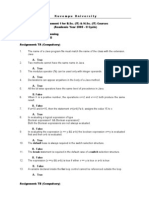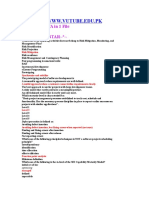JavaScript For Loop
Uploaded by
RonaldAroganteJavaScript For Loop
Uploaded by
RonaldAroganteJavaScript For Loop
Previous
Next Chapter
Loops can execute a block of code a number of times.
JavaScript Loops
Loops are handy, if you want to run the same code over and over again, each time with a
different value.
Often this is the case when working with arrays:
Instead of writing:
text += cars[0] + "<br>";
text += cars[1] + "<br>";
text += cars[2] + "<br>";
text += cars[3] + "<br>";
text += cars[4] + "<br>";
text += cars[5] + "<br>";
You can write:
for (var i = 0; i < cars.length; i++) {
text += cars[i];
}
Try it Yourself
Different Kinds of Loops
JavaScript supports different kinds of loops:
for - loops through a block of code a number of times
for/in - loops through the properties of an object
while - loops through a block of code while a specified condition is true
do/while - also loops through a block of code while a specified condition is true
The For Loop
The for loop is often the tool you will use when you want to create a loop.
The for loop has the following syntax:
for (statement 1; statement 2; statement 3) {
code block to be executed
}
Statement 1 is executed before the loop (the code block) starts.
Statement 2 defines the condition for running the loop (the code block).
Statement 3 is executed each time after the loop (the code block) has been executed.
Example
for (var i = 0; i < 5; i++) {
text += "The number is " + i + "<br>";
}
Try it Yourself
From the example above, you can read:
Statement 1 sets a variable before the loop starts (var i = 0).
Statement 2 defines the condition for the loop to run (i must be less than 5).
Statement 3 increases a value (i++) each time the code block in the loop has been executed.
Statement 1
Normally you will use statement 1 to initiate the variable used in the loop (var i = 0).
This is not always the case, JavaScript doesn't care. Statement 1 is optional.
You can initiate many values in statement 1 (separated by comma):
Example:
for (var i = 0, len = cars.length, text = ""; i < len; i++) {
text += cars[i] + "<br>";
}
Try it Yourself
And you can omit statement 1 (like when your values are set before the loop starts):
Example:
var i = 2;
var len = cars.length;
var text = "";
for (; i < len; i++) {
text += cars[i] + "<br>";
}
Try it Yourself
Statement 2
Often statement 2 is used to evaluate the condition of the initial variable.
This is not always the case, JavaScript doesn't care. Statement 2 is also optional.
If statement 2 returns true, the loop will start over again, if it returns false, the loop will end.
If you omit statement 2, you must provide a break inside the loop. Otherwise the loop will
never end. This will crash your browser. Read about breaks in a later chapter of this
tutorial.
Statement 3
Often statement 3 increases the initial variable.
This is not always the case, JavaScript doesn't care, and statement 3 is optional.
Statement 3 can do anything like negative increment (i--), or larger increment (i = i + 15), or
anything else.
Statement 3 can also be omitted (like when you increment your values inside the loop):
Example:
var i = 0;
len = cars.length;
for (; i < len; ) {
text += cars[i] + "<br>";
i++;
}
Try it Yourself
The For/In Loop
The JavaScript for/in statement loops through the properties of an object:
Example
var person = {fname:"John", lname:"Doe", age:25};
var text = "";
for (var x in person) {
text += person[x];
}
Try it Yourself
The While Loop
The while loop and the do/while loop will be explained in the next chapter.
You might also like
- Complete A Z Javascript Notes 1682741974No ratings yetComplete A Z Javascript Notes 168274197485 pages
- JSP-Servlet Interview Questions You'll Most Likely Be AskedFrom EverandJSP-Servlet Interview Questions You'll Most Likely Be AskedNo ratings yet
- Oracle 1Z0-809 Exam Practice Dumps DownloadNo ratings yetOracle 1Z0-809 Exam Practice Dumps Download8 pages
- JavaScript Practice Programs (Questions)No ratings yetJavaScript Practice Programs (Questions)51 pages
- Inline CSS:: CSS: Cascading Style SheetNo ratings yetInline CSS:: CSS: Cascading Style Sheet44 pages
- Cse Programming For Problem Solving Model Question Papers 2100% (1)Cse Programming For Problem Solving Model Question Papers 24 pages
- Javascript Interview Questions and AnswersNo ratings yetJavascript Interview Questions and Answers20 pages
- BSC Sem4 Java Programming Assignment 1 AnsNo ratings yetBSC Sem4 Java Programming Assignment 1 Ans5 pages
- Top 40 Javascript Interview Questions and AnswersNo ratings yetTop 40 Javascript Interview Questions and Answers12 pages
- JAVA QUESTIONS 1 (24.1.22) : A. 1, 2, 4 B. 2, 4, 5 C. 2, 3, 4 D. All Are Correct. Answer: Option ANo ratings yetJAVA QUESTIONS 1 (24.1.22) : A. 1, 2, 4 B. 2, 4, 5 C. 2, 3, 4 D. All Are Correct. Answer: Option A9 pages
- Web Technology Lab: Department of Computer Science & EngineeringNo ratings yetWeb Technology Lab: Department of Computer Science & Engineering42 pages
- AP LAWCET 3 Years LLB 2015 Question Paper & Key PDFNo ratings yetAP LAWCET 3 Years LLB 2015 Question Paper & Key PDF29 pages
- Python Coding Interview Questions For FreshersNo ratings yetPython Coding Interview Questions For Freshers6 pages
- Advanced Android Development Course: Brought To You by The Google Developers Training TeamNo ratings yetAdvanced Android Development Course: Brought To You by The Google Developers Training Team46 pages
- JavaScript Syntax, Part I - Learn JavaScript Syntax - Introduction Cheatsheet - Codecademy100% (1)JavaScript Syntax, Part I - Learn JavaScript Syntax - Introduction Cheatsheet - Codecademy6 pages
- ColdFusion Interview Questions, Answers, and Explanations: ColdFusion Certification ReviewFrom EverandColdFusion Interview Questions, Answers, and Explanations: ColdFusion Certification ReviewNo ratings yet
- JavaInterviewQuestions UdemyCourse September201675% (4)JavaInterviewQuestions UdemyCourse September2016109 pages
- 4700 - INFO - VITEK2 Systems - Special Characters in FLEXprep Accession IDsNo ratings yet4700 - INFO - VITEK2 Systems - Special Characters in FLEXprep Accession IDs3 pages
- 8 BrocadeSWSupportRM119 1711464357596 03262024074707No ratings yet8 BrocadeSWSupportRM119 1711464357596 0326202407470716 pages
- Python Machine Learning Workbook For BeginnersNo ratings yetPython Machine Learning Workbook For Beginners264 pages
- ChiragMangla - Hadoop Architecture Lab PracticalNo ratings yetChiragMangla - Hadoop Architecture Lab Practical36 pages
- Data Transfers, Addressing, and ArithmeticNo ratings yetData Transfers, Addressing, and Arithmetic21 pages
- 520GH训练营 - 周其衡 - 客户案例分享:GitHub Copilot 最佳实践解读No ratings yet520GH训练营 - 周其衡 - 客户案例分享:GitHub Copilot 最佳实践解读24 pages
- Software Engineering II - CS605 Mid Term Solved Mcqs100% (1)Software Engineering II - CS605 Mid Term Solved Mcqs75 pages

























































































